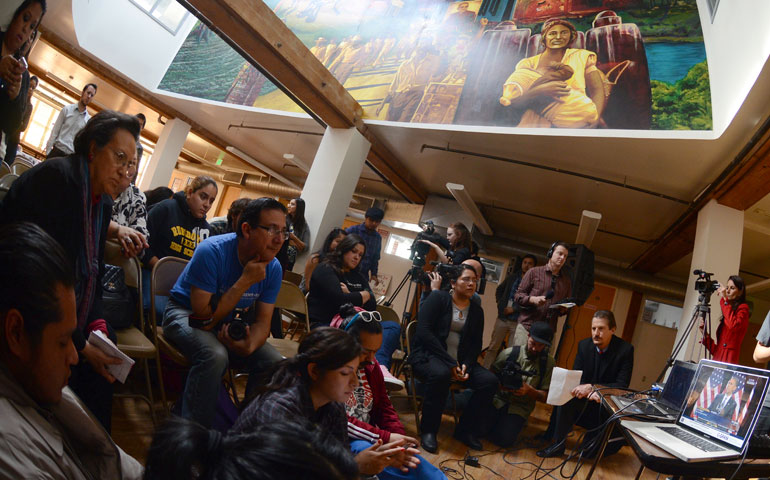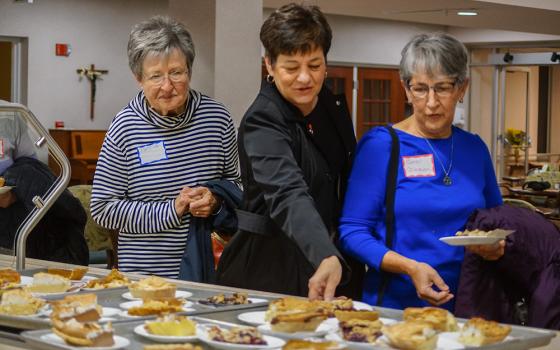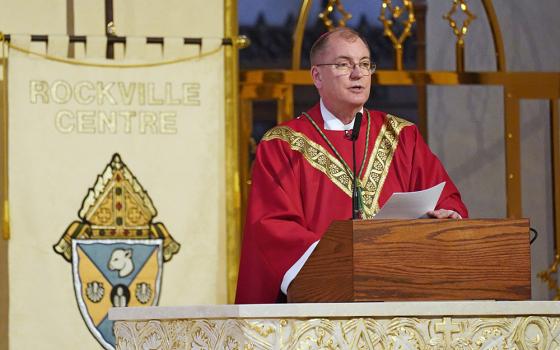
At the Central American Resource Center in Los Angeles, undocumented immigrants, faith- based leaders, labor activists and allies watch President Barack Obama in Las Vegas deliver his plan for immigration reform Jan. 29. (Newscom/Getty Images/AFP/Joe Klamar)
Two separate but similar plans announced in the final days of January placed the political spotlight on U.S. immigration reform, setting the stage for debate and outlining the path to citizenship for 11 million illegal immigrants already in the country.
In announcements made 2,400 miles apart, President Barack Obama and a contingent of leading senators unveiled plans that called for strengthening borders while simultaneously confronting the reality that deportation isn't an option with undocumented immigrants numbering eight digits.
"We have been too content for too long to allow individuals to mow our lawns, grow our food, clean our homes, and even watch our children while not affording them any of the benefits that make our country so great," Sen. John McCain said during a press conference Jan. 28 in Washington with seven fellow senators.
The bipartisan "Gang of Eight" proposed a comprehensive immigration plan based upon four pillars: create a "tough but fair" path to citizenship while securing borders; improve a broken legal immigration system by removing roadblocks to family reunification and for top foreign students; develop a fast and reliable employment verification system; and establish a process to allow businesses to hire immigrant workers when Americans are unable or unwilling to fill the positions.
Gang of Eight senators include McCain, R-Ariz.; Charles E. Schumer, D-N.Y.; Richard Durbin, D-Ill.; Lindsey Graham, R-S.C.; Bob Menendez, D-N.J.; Marco Rubio, R-Fla.; Michael Bennett, D-Colo.; and Jeff Flake, R-Ariz.
Their road map to citizenship would require all illegal immigrants to first register with the government by passing a background check, and to pay a fine and back taxes in order to attain probationary legal status, allowing them to work and live legally in the U.S. From there, they would go behind the legal immigrants applying for green cards already in line. That process requires passing additional background checks, paying taxes, learning English, and demonstrating current and past employment.
Immigrants brought to the U.S. as minors and those working in the agricultural industry would be subject to an alternate, likely easier, process.
"The politics of fear is shifting to the politics of possibilities," said Holy Cross Fr. Daniel G. Groody, an associate professor of theology and director of the Center for Latino Spirituality and Culture at the University of Notre Dame.
Without seeing the final forms the proposals take, Groody, who has written extensively on immigration, told NCR the narratives they cast show the national debate is moving away from seeing immigrants as a threat, to recognizing their potential for the nation.
Coming a day after the Gang of Eight and a week before the House Judiciary Committee began its own discussions, the president's plan, presented during a speech at Del Sol High School in Las Vegas, applauded the senators' efforts while outlining his own agenda.
"If we're truly committed to strengthening our middle class and providing more ladders of opportunity to those who are willing to work hard to make it into the middle class, we've got to fix the [immigration] system," he said.
Obama's plan, which comes nearly three months after he won a second term carrying 71 percent of the Hispanic vote, shared many reforms with the senators, primarily in the path to citizenship, continued fortifying of U.S. borders, and streamlining the legal immigration system. It would also seek additional visas to keep intact families, including those with same-sex parents, and offer DREAMers -- children brought here illegally -- an opportunity for citizenship through college or the military.
In his speech, Obama cited economics among the reasons for reform. Businesses hiring undocumented workers and paying them minimal wages create an unfair playing field, he said. The current system also deters promising foreign students from remaining in the country and contributing to the economy.
The prerequisites in both immigration proposals, combined with current laws, all but assure the pathway to citizenship won't be a clear-cut trail. The Senate plan would stall the green card process until borders are deemed secure and an entry-exit system to track legal immigrants leaving when required is in place. Even then, U.S. law requires a five-year waiting period after receiving a green card before any person can apply for full citizenship.
"It won't be a quick process but it will be a fair process," Obama said.
Religious groups have received the plans with both applause and concern. The U.S. Jesuit Conference praised the senators' bipartisanship, but worried about starting the legalization process only after securing the borders, a sentiment U.S. bishops share.
"I think our concern would be the opposite," Bishop Gerald Kicanas of Tucson, Ariz., told NCR, "that if we can resolve the immigration policy, border enforcement will be able to happen more effectively," since resources could focus on drug and human trafficking rather than on those seeking a better life.
The Jesuit Conference, in its statement, said delaying legalization implementation until "achieving an impervious border … will leave millions of lives in limbo and prolong indefinitely the irregular status of our undocumented brothers and sisters."
Sojourners, a national Christian social justice group, described both plans as reflecting the principle that "our immigration system must treat people fairly and provide the opportunity for people to flourish as God intends."
Addressing the exploitation of immigrant workers quickly will aid in protecting all workers from abuses, said Kim Bobo, executive director of Interfaith Worker Justice.
"Reforming our immigration system is morally imperative and fundamental to restoring justice and equity in the workplace and the community," she said in a statement.
The U.S. bishops saw the Gang of Eight plan aligning along several of their core policy goals -- a path to citizenship and protections for families and workers -- but fell short of restoring immigrants' due process rights and addressing the root causes of migration.
"A reformed system can protect human dignity and the homeland at the same time," said Los Angeles Archbishop Jose Gomez, chair of the bishops' Committee on Migration.
Even with those reservations, many welcomed the plans as a necessary first step in re-engaging the issue of immigration.
"I do believe that this is a very advantageous moment that perhaps our country can resolve something that has been broken for a long time," said Kicanas, whose diocese in southern Arizona has a front-row view of the immigrant movement.
The bishop said that a combination of an improving Mexican economy and fewer employment opportunities in the U.S. has helped stem the wave of immigrants crossing the border illegally, with 2011 recording nearly a third of the 2005 peak of 1.1 million.
Compared to past debates over immigration, Kicanas noted that the tone this time has changed. In 2010, Arizona captured the nation's attention as it passed strict immigration laws that allowed authorities to question immigration status while enforcing other laws, a practice opponents labeled as racial profiling. In a recent visit to the state capitol, the bishop saw a legislature more open to discussion of the people already living in the state.
"There aren't the same kind of proposals coming forth that would have happened several years ago, so I think that's very encouraging," he said.
Nationally, immigration legislation in recent decades has either failed or only partially addressed the problem. McCain and the late Sen. Ted Kennedy either spearheaded or supported multiple reform efforts from 2005-2008. The terrorist attacks of Sept. 11 derailed an attempt under President George W. Bush. From there, the focus shifted almost exclusively to border security, by constructing a fence along parts of the Mexican border and increasing resources to Border Control, who have conducted operations at key entry points (El Paso, Texas; San Diego; Tucson) since the early 1990s.
"After 9/11, pretty much the terrorism thing just brought the gates down, and from then on end, we've literally been governed by a politics of fear," Groody said, adding that seriously addressing immigration requires a broader, global vision to understand the motivations for migration.
The last major immigration overhaul came in 1986. President Ronald Reagan hailed the passage of the Immigration Reform and Control Act -- a plan that also sought a pathway to citizenship, increased border enforcement, and penalties to deter business from hiring undocumented workers -- but in recent years, some have criticized it for only inflating the problem. At the time of its passage, there were roughly 3 million to 5 million illegal immigrants.
Kicanas sees a hopeful mood settling in southern Arizona. Before speaking about immigration at a fundraiser dinner in El Paso, he first visited with students at Cathedral High School and asked them what he should say.
"Something is changing," Kicanas said one student told him. "The mood is changing, where I heard so many people so negative about us as people from Mexico coming into the United States, I hear now more positive tone and maybe that's what needs to be said."
[Brian Roewe is an NCR staff writer. His email address is broewe@ncronline.org.]




